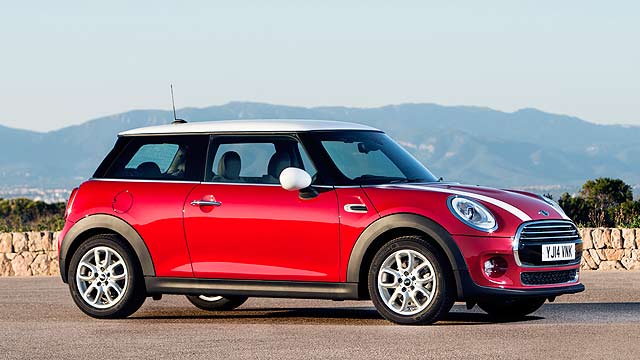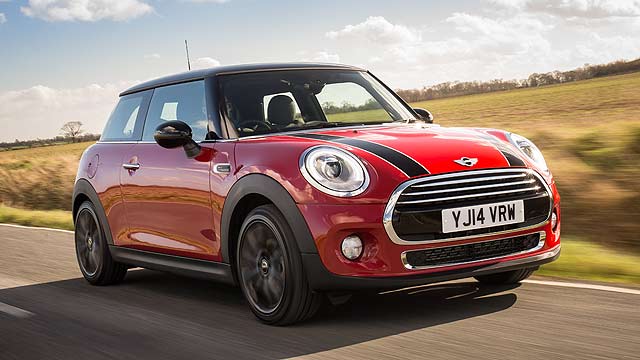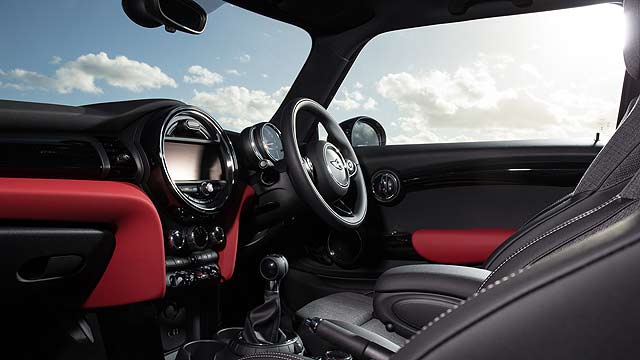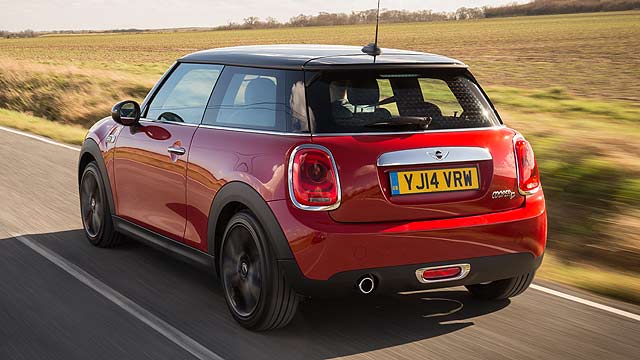Richard Aucock | March 2014
BMW has built a staggering 2.4 million new MINI since the first generation Hatch was launched in 2001. The latest car aims to build upon this success: a ground-up all-new car, bosses claim it the evolutionary leap with this third generation model is twice as large as that between Mk1 and Mk2 cars.
Not that you’d believe it to look at it? Well, of course it still looks like a MINI. But, in the metal, there’s more of a stepchange than is first apparent, particularly in the car’s stance and silhouette. The MINI-shaped panels are, well, shapelier, with more careful surfacing: the newfound form in the side is particularly appealing.
You will notice the front overhang is longer. Inevitable, says MINI, due to pedestrian protection rules. And the car overall is thus longer too – but it still remains the shortest small car in its class. A MINI is 13cm shorter than an Audi A1, and 15cm shorter than a Ford Fiesta; it’s an amazing 24cm shorter than an Alfa Romeo MiTo.
The range is based around One, Cooper and Cooper S variants, with diesel ‘D’ equivalents of the first two (a Cooper SD shouldn’t be ruled out). Core models have 1.5-litre BMW TwinPower Turbo engines, with three cylinders: the Cooper S boasts a 2.0-litre four-cylinder with an appealing-sounding 189hp.
All engines are more powerful yet more economical than before, with the Cooper petrol leading the way – 62.8mpg and 105g/km CO2, but 134hp and a wild 169lb ft of torque. A full three seconds have been chopped off its 0-62mph time.
The Cooper models are the MINIs that will sell best. Almost one in two will be a Cooper or Cooper D. It was the latter that introduced us to the new MINI, complete with 116hp engine boasting 199lb ft of torque, 0-62mph in 9.2 seconds but 80.7mpg and 92g/km CO2. On paper, it all sounds good. Question is, has BMW retained the MINI magic?
What is the 2014 MINI Cooper D Hatch like to drive?
Panic over: it’s still a MINI. The vibrancy, the handling excellence, the youthful nature, all are still in evidence. It is light on its feet and really feels a cut above the supermini norm – it is still something special to drive.
This is all despite the new MINI being based on a new BMW platform, called UKL. This will underpin umpteen other models, such as the BMW 2 Series Active Tourer. It brings new levels of safety, refinement and engineering to the MINI but, vitally, doesn’t make the car feel like an exec BMW rather than an amusing MINI. The magic is still there.
Even in the cooking Cooper, body roll is minimal and the turn-in of the car is instant: it feels really pert and lithe, with not a trace of sog or slop. Grip levels are very high and the well balanced confidence it brings is very rewarding and feel-good. You feel there’s some really expensive engineering beneath it – and the sense its multi-link rear is contributing just as much as the front means there’s not a small car on sale that has this much ability.
We say the latter with confidence, because the MINI does something else much better: ride well. BMW hasn’t softened and spoiled it, but it has significantly improved the compliance and bump absorption of the suspension. It’s also taken away the spine-compressing stiffness of the springs, and even tuned out the noise of the suspension reacting to bumps.
It’s not perfect. The steering is our chief gripe. It’s still really fast and immediate, and a combination of exceptional front-end bite plus pure mechanical feedback means it feels like a well bred hot hatch in corners. But the weighting of the steering is obviously electronic, has too many odd variances for our liking and also suffers from faint, jagged ‘pulses’ as you turn through the centre in slightly over-stiff Sport mode. You must accustom to a greater touch of on-centre cushioning before the system reacts with alacrity too.
The diesel engine is hard to fault though. Very smooth and free revving, it has a confident strength of pull even from walking pace revs, with no diesel breathlessness at high revs either. Rifle through the meaty, precise six-speed gearbox and there’s no turbo drop-off between gearchanges to speak of, adding to its linear feel – only when going back on the throttle at a cruise will you notice the gulp-pause delay from the turbo. Overall, it’s swifter than the old diesel and, more noticeably, appreciably nicer to use.
Is the new MINI Hatch still mini?
It drives like a MINI then. But it’s less mini inside, fortunately. It passes the ‘sit behind yourself’ test with aplomb, with perfectly acceptable space for an adult’s feet, knees and head (the old car had almost none here). The boot is 30% bigger too, and cleverer: 60:40 split seats are new, as is a dual height floor whose divider can be clipped vertically in place to reveal the full 211-litre space.
The interior has traded some of the old MINI cuteness for BMW-like sophistication and quality. It looks much more premium, with really smart attention to detail, and relocating the dials to the steering wheel console has freed the big central circle to take optional BMW-grade infotainment systems (at 8.8 inches, no small car has a bigger colour screen). You can have an emergency call system, the app-laden MINI Connected setup or a new MINI Connected XL that includes its own smartphone app that lets you send sat nav routes to the car from your living room couch and much more.
Plenty more BMW tech is optionally available as well, such as head up displays, radar cruise control, high-end stereos (the standard one is pretty good, mind) and pedestrian-monitoring auto-braking. There’s a new hands-free parking gadget and it’s the first MINI to have VDC variable suspension dampers.
That centre circle has a new trick: colour-changing LEDs, which act as a visual signal for numerous functions. It can be a rev counter redline, a green mode indicator, even a countdown for the sat nav instructions. It seems to do much more than you’ll work out in a few hours behind the wheel. But what comfortable hours they’ll be, thanks to bigger and vastly improved new seats, which are far more supportive, well bolstered and BMW-grade.
The MINI itself is significantly quieter and existing owners will really notice this. At 30mph, the additional peace is almost spooky, so distant is road, wind and engine noise. It continues at speed too, with almost family hatch levels of refinement on the motorway. The quality of the noise is better too, from the tuneful throb of the diesel engine (which only really grumbles at tickover when cold) to the distant thud (not crash) of wheels hitting potholes.
MR VERDICT: 2014 MINI Cooper D Hatch
What a relief: it’s still a MINI, rather than a mini BMW. Even this standard car is fun and well bred, with sports car engineering to the chassis that means it’s hugely satisfying to drive. The engine is better, the steering is good despite its perceived imperfections and the overall driving standards of the car reach a new high.
But it’s the added extras that clinch it; the much improved ride, the significantly better refinement at all speeds, the higher quality interior, the newfound space and practicality. We even like how it looks – still a MINI but a modernised MINI. Overall, hard to fault. If you’re one of the millions of MINI drivers who already like their car, you are going to love this one.
Rivals
Audi A1
Fiat 500
Citroen DS3
Ford Fiesta
Nissan Juke
Specification: 2014 MINI Cooper D Hatch
Engine 1.5-litre three-cylinder turbodiesel
Drivetrain Six-speed manual, front-wheel drive
Price £16,450
Power 116hp
Torque 199lb ft
0-62mph 9.2secs
Top speed 133mph
MPG 80.7mpg
CO2 92g/km











